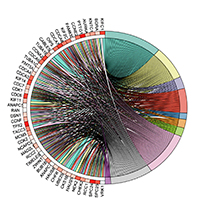The clinical significance of UBE2C gene in progression of renal cell carcinoma

Submitted: 9 November 2020
Accepted: 10 February 2021
Published: 29 March 2021
Accepted: 10 February 2021
Abstract Views: 1090
PDF: 616
HTML: 10
HTML: 10
Publisher's note
All claims expressed in this article are solely those of the authors and do not necessarily represent those of their affiliated organizations, or those of the publisher, the editors and the reviewers. Any product that may be evaluated in this article or claim that may be made by its manufacturer is not guaranteed or endorsed by the publisher.
All claims expressed in this article are solely those of the authors and do not necessarily represent those of their affiliated organizations, or those of the publisher, the editors and the reviewers. Any product that may be evaluated in this article or claim that may be made by its manufacturer is not guaranteed or endorsed by the publisher.
Similar Articles
- L. Casadei, L. Vallorani, A.M. Gioacchini, M. Guescini, S. Burattini, A. D'Emilio, L. Biagiotti, E. Falcieri, V. Stocchi, Proteomics-based investigation in C2C12 myoblast differentiation , European Journal of Histochemistry: Vol. 53 No. 4 (2009)
- G Pons, V Evangelisti, F Caprì, S Mozzone, A Viarengo, Cytochemical localization and quantification of plasma membrane Ca2+-ATPase activity in mollusc digestive gland cells , European Journal of Histochemistry: Vol. 46 No. 1 (2002)
- A Zulli, LM Burrell, BF Buxton, DL Hare, ACE2 and AT4R are present in diseased human blood vessels , European Journal of Histochemistry: Vol. 52 No. 1 (2008)
- D Kluchová, S Rybárová, M Miklošová, K Lovásová, K Schmidtová, F Dorko, Comparative analysis of NADPH-diaphorase positive neurons in the rat, rabbit and pheasant thoracic spinal cord. A histochemical study , European Journal of Histochemistry: Vol. 45 No. 3 (2001)
- R Acevedo, A Cuadrado, C De la Torre, S Moreno Díaz de la Espina, Behaviour of ribosomal genes and nucleolar domains during activation in sugarcane (Saccharum officinarum L.) root primordia: from the unsoaked quiescent state to the steady state of proliferation , European Journal of Histochemistry: Vol. 46 No. 2 (2002)
- A Sun, S Noriki, Y Imamura, M Fukuda, Detection of cancer clones in human gastric adenoma by increased DNA-instability and other biomarkers , European Journal of Histochemistry: Vol. 47 No. 2 (2003)
- Claudio Pigoli, Lucia Rita Gibelli, Mario Caniatti, Luca Moretti, Giuseppe Sironi, Chiara Giudice, Bleaching melanin in formalin-fixed and paraffin-embedded melanoma specimens using visible light: a pilot study , European Journal of Histochemistry: Vol. 63 No. 4 (2019)
- The Scientific Committee, Proceedings of the 66th Congress of the GEI-Italian Society of Development and Cell Biology (GEI-SIBSC) - Milan, 22 June 2021 , European Journal of Histochemistry: Vol. 65 No. s2 (2021): 66th Congress of the GEI-Italian Society of Development and Cell Biology (GEI-SIBSC) - Milan, 22 June 2021
- M.I. Dávila-RodrÃguez, Elva I. Cortés-Gutiérrez, R.M. Cerda Flores, M. Pita, J.L. Fernández, C. López-Fernández, J. Gosálvez, Constitutive heterochromatin polymorphisms in human chromosomes identified by whole comparative genomic hybridization , European Journal of Histochemistry: Vol. 55 No. 3 (2011)
- T Pederson, The molecular cytology of gene expression: fluorescent RNA as both a stain and tracer in vivo , European Journal of Histochemistry: Vol. 48 No. 1 (2004)
<< < 69 70 71 72 73 74 75 76 77 78 > >>
You may also start an advanced similarity search for this article.

 https://doi.org/10.4081/ejh.2021.3196
https://doi.org/10.4081/ejh.2021.3196










